Brief

Retail sales in November and December grew squarely in line with Bain’s forecast. Sales rose 3.8% over the holiday season, with sales of health and personal care products and furniture and home products growing most rapidly. E-commerce sales posted 16% to 19% growth. In this issue we recap the results from the holiday season and share the most important trends that retailers should embrace in 2017.
Wrapping up the holidays
Preliminary estimates indicate that retail sales grew 3.8% this holiday season over last year (see Figure 1), slightly below the five-year average of 3.9% and in line with Bain’s forecast of 3.5% to 3.9%. Although overall growth was strong, there was significant variation across categories and retailers with a wide range of results. Several retailers reported sales growth in the mid- to high single-digits, while several others actually saw sales fall over the holiday season. E-commerce—with considerable strength in mobile sales—continued to outperform stores. Core retail sales were tempered by an ongoing shift in spending to noncore retail sectors (cars and gas stations, for example).
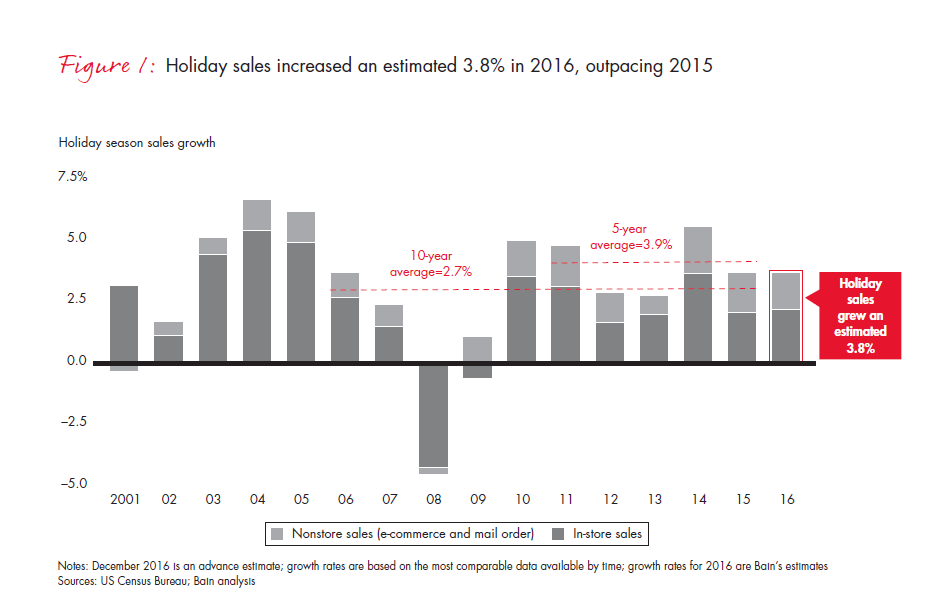
Although retailers had hoped to reduce promotional activity this year, most reports point to big increases in both the breadth and the depth of discounting. For example, Dynamic Action suggests the number of receipts with items purchased on promotion jumped 79% in November and more than doubled the first week of December compared with the same period in 2015. Of 21 major retailers tracked by Nomura Instinet, 9 offered deeper discounts on Super Saturday (the Saturday before Christmas) this year.
As more and more purchases are made using multiple channels—a sweater discovered in a television commercial, comparison-shopped online, ordered on a mobile phone and picked up at a store, for example—the accounting for in-store sales vs. e-commerce sales blurs. Conventional metrics classify items that are ordered online as e-commerce sales, even if those items are collected from a physical store. And items that are purchased in a store are classified as store sales, even if those items were researched online or shipped to another location.
Data just released by the US Census Bureau indicates that in-store sales grew by 2.3% this holiday season, slightly above last year’s 2.1%. Keep in mind, however, that this rate is an estimate and may well be revised. Over the past five years, holiday growth numbers have varied by 50 to 200 basis points from initial estimates (see Exhibit 1). Within the core retail sector, holiday sales were strongest in the health and personal care and the furniture and home categories (see Figure 2). While department stores and mass merchants saw slower growth this holiday season, discounters like T.J.Maxx, Ross Stores and Burlington reported strong third-quarter sales growth compared with the same period last year. Grocery prices, which have suffered from deflation throughout 2016, continued to fall in November and December.
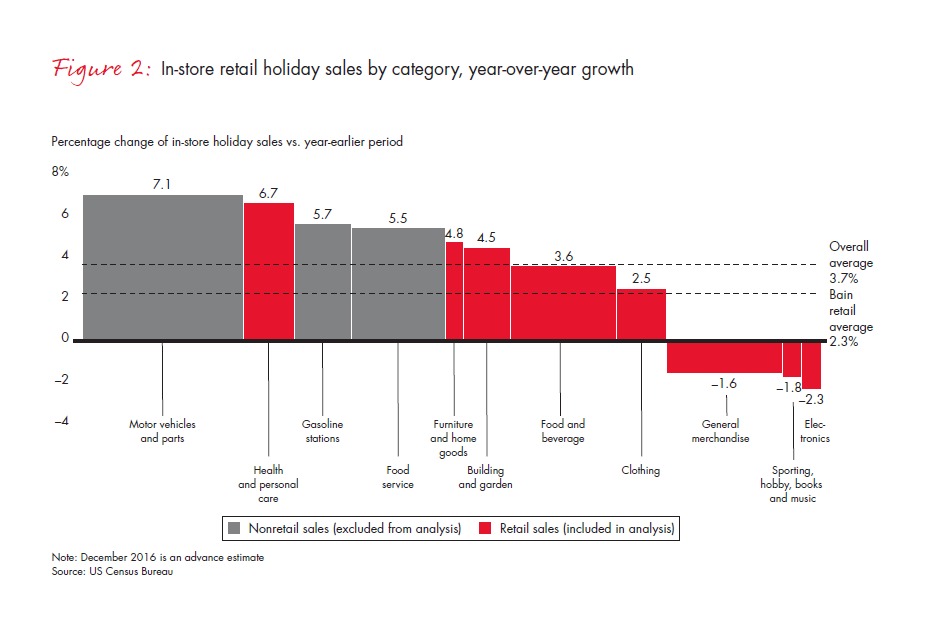
The Census Bureau does not release an advance estimate for e-commerce holiday sales, and third-party estimates for e-commerce range widely—from 11% to 20% (see Figure 3). ComScore, a frequently cited reference point, reports a 16% to 19% increase in digital sales this holiday season, compared with 13% growth last year. We partnered with credit card transaction analytics firm TXN Solutions to examine a basket of 17 large retailers and saw a shift of more than 100 basis points toward online sales from last year’s holiday period to this year’s (see Figure 4).
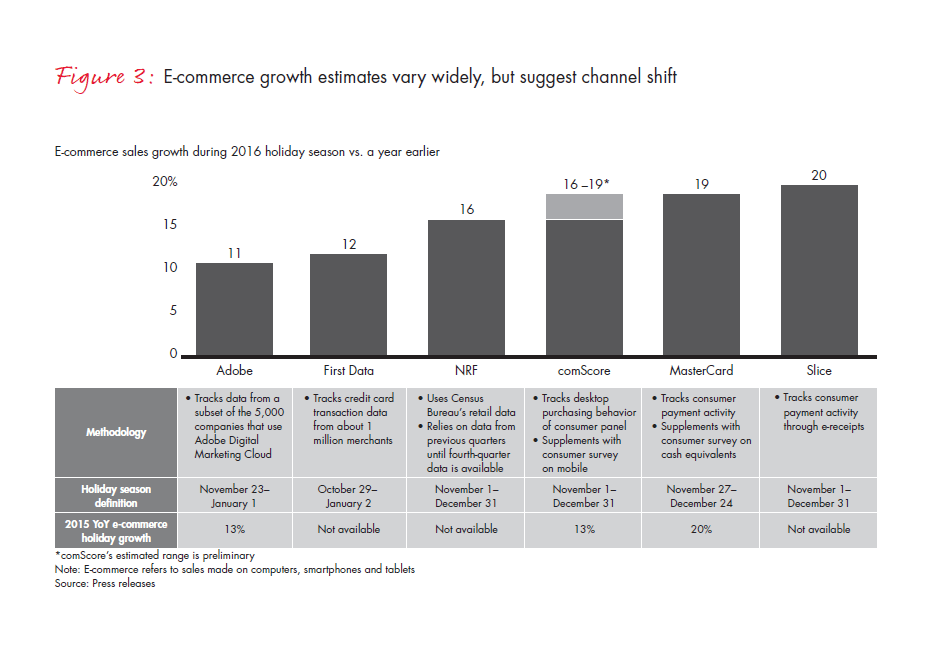
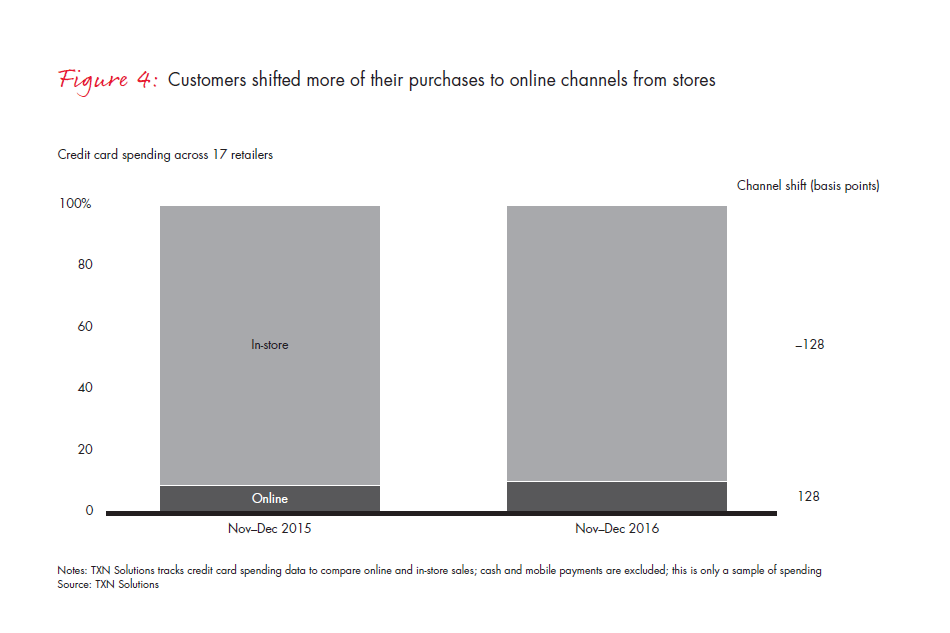
It’s important to remember that estimates understate the influence of e-commerce. As part of Bain’s Shopping Experience Pulse, a survey we conducted in partnership with Research Now, we asked customers if they browsed or did research on Amazon.com before making a purchase at a different retailer. We learned that 35% of shoppers who made a purchase in a store did go to Amazon first, typically comparing prices before buying.
E-commerce sales overall were strong; within those numbers, sales through mobile devices grew considerably faster than sales through personal computers. Based on data from Adobe, mobile sales grew 36% and accounted for an estimated 21% of online sales in November and December. A big reason for this growth? App downloads and use. Although most online touchpoints happen on mobile-optimized websites, consumers spend more time using retailers’ apps, and conversion rates on those apps are higher than on the mobile-optimized web. In partnership with app analytics firm Apptopia, we found that retailers’ mobile app engagement, as measured by unique monthly users, spiked as much as 35% this holiday season (see Figure 5). In fact, several retailers offered mobile-exclusive holiday-themed promotions. For example, Target’s Cartwheel app offered a 50% discount on a different toy each day from November 1 through December 24.

Among e-commerce winners, Amazon topped the list. Bain’s Shopping Experience Pulse survey shows that Amazon’s customers continued to report a higher satisfaction rating than customers who shopped in physical stores or even on the websites of retailers with physical stores—with an Amazon Net Promoter Score® of 51 compared with 25 and 40, respectively.1 In terms of shoppers who bought items in stores, there was a clear drop in satisfaction from the first half to the second half of December—the Net Promoter Score falling from 36 to 25. For those who were dissatisfied with their experience at physical stores, two issues were mentioned more frequently in the second half of December than in the first half: customer service and product offerings (specifically a “limited selection” or the store “didn’t have what I wanted”). Customer satisfaction with Amazon and physical stores’ websites remained flat over the same period.
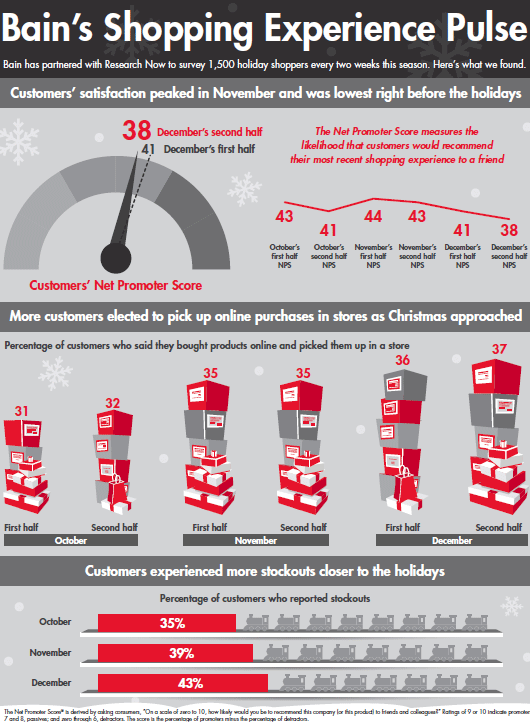
10 opportunities for the new year
There are countless trend forecasts at this time of year. Most focus on whiz-bang technologies that sound cool but won’t be profitable for years. Preparing dinner on a 3-D printer may be feasible someday (as The Jetsons predicted more than 50 years ago); but for most retailers, diverting resources to speculation over the long term isn’t practical. The greatest challenge facing retail executives isn’t finding technologies in which they could invest; it’s deciding where to focus their investments for profitable growth now. Here we want to highlight trends that have the highest cost of delay (see Figure 6). In other words, three years from now, which trends would retailers most regret not pursuing aggressively in 2017?
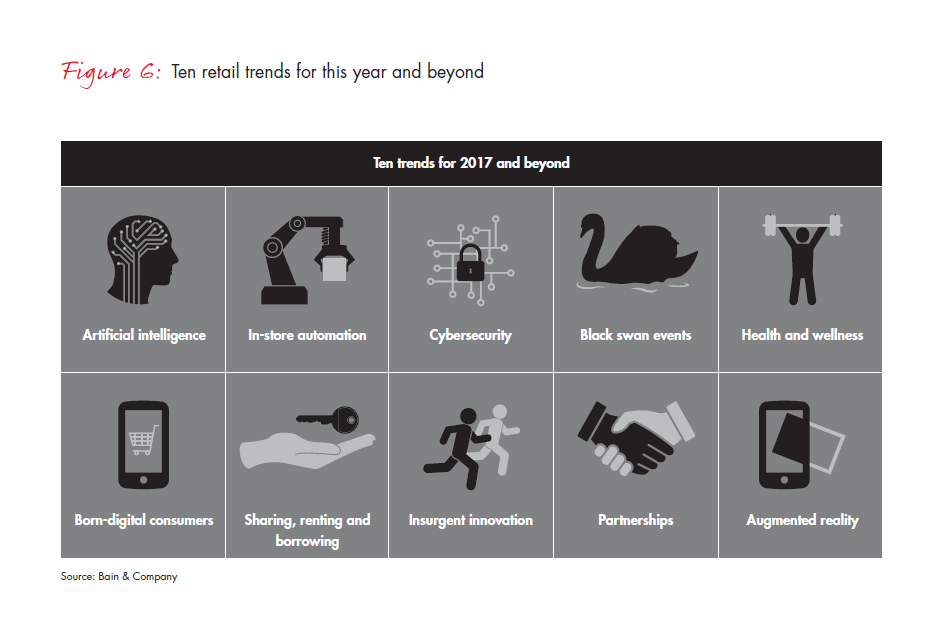
Artificial intelligence: Harnessing machine learning in retail
Artificial intelligence (AI) refers to computer programs and machines that are capable of learning, solving problems and making decisions. These programs and machines don’t rely on programmers to refine algorithms. Instead, by recognizing patterns in massive data sets, they create their own decision rules. AI is no longer a Silicon Valley pipe dream; it’s a real and actionable asset for retailers, helping improve both the customer’s experience and the retailer’s operations. For example, AI voice-recognition technology is the backbone of several new home assistants, including Google Home and Amazon’s Echo, which sold out over the holidays. Macy’s is piloting Macy’s On-Call, a mobile web tool powered by IBM’s Watson technology, which helps customers find products and more easily navigate stores. AI is also boosting the performance of tools and technologies that have historically been awkward and frustrating. Image-recognition error rates have dropped more than 20% in the past four years; Microsoft’s AI technology recently outperformed human speech-recognition abilities; and for certain languages, the Google Neural Machine Translation system is approaching human-level accuracy. Clearly it’s time to explore AI.
In-store automation: Improving productivity with robots, sensors and cameras
The automation of basic tasks and services isn’t new, but the rapid drop in the cost of key technologies is making the economics of implementing these solutions far more appealing. Some examples: SoftBank Robotics has created Pepper, a robot that uses facial recognition and language processing to serve customers in retail environments ranging from Nissan showrooms to Nescafé shops. At the Amazon Go pilot store, sensors and cameras mean customers can simply walk out with their purchases—no checkout needed. And Hointer is turning apparel and grocery stores into “Microwarehouses” where customers can choose from goods on display and then pick up their choices at designated stations or have them delivered the same day. Among the benefits: more selection in less space, clutter-free stores that customers find aesthetically pleasing and more time for sales associates to focus on customer service. What we’re seeing is new ways of thinking, shifting the conversation from “Does this technology work?” to “Which aspects of my business are most ripe for automation?”
Cybersecurity: Protecting customers and their trust
Cybersecurity is the use of software and services to protect a company’s computer systems and customers from the theft of data or damage to data, software or hardware. The more people shift to digital technologies, the more criminals are looking for ways to capitalize on that shift. Cyberattacks are becoming increasingly common and sophisticated, threatening one of retailers’ most valued assets: customer trust. Retailers account for only 6% of all data breaches; but because these breaches often involve customers’ personal information, they tend to make headlines. Target’s data breach in 2013 put millions of customers on edge and cost the company significant time, energy and money to regain their trust. Eddie Bauer is among a number of retailers that recently fell victim to attacks that compromised customers’ credit card data. Last winter, scammers went phishing using fake emails from Macy’s. The bait: links for shoppers to claim a monthly prize. In 2017 and beyond, cybersecurity will be an increasingly important part of doing business. Earlier this month, Amazon Web Services purchased a cybersecurity firm to further protect the data it hosts on its cloud servers.
Black swan events: Preparing for the unexpected
Black swan events vary significantly, and sometimes disastrously, from expectations. Recently we’ve seen bathroom signs inspire boycotts, labor laws swiftly reversed and terrorist attacks spark new safety protocols. On the positive side, we’ve also seen a video of a laughing mom trying on a mask from Kohl’s go viral overnight. In short order, the company sold out of Chewbacca masks. In today’s connected world, surprising events shared through the megaphone of social media often catch retailers off guard. Success requires executives to consider a broad range of scenarios, developing plans to minimize the effects of negative events and maximize the benefits of positive opportunities. The process not only shortens response times; it also helps teams react more effectively when a black swan event does occur.
Health and wellness: Making good choices easier
Many consumers say they care about health and wellness; a growing number are even willing to pay more for it. From 2006 to 2016, annual sales of organic packaged foods grew more than 10 times the sales of packaged foods as a whole. That growth happened despite relatively high costs: Organic foods are almost 50% more expensive on average. However, as Panera’s cofounder and CEO Ronald Shaich has said, “The consumer wants food that is both good for them and is simply good.” Companies are responding to consumers’ preference for good and good-for-you foods by making existing and new products healthier. Sephora has a dedicated section on its website for natural makeup that lists what consumers won’t find in the products (for example, parabens, sulfates and phthalates); and Target and Walmart have both pledged to provide safer chemicals in beauty, household cleaning and baby products. Additionally, the urge to monitor and track everything continues to gain momentum: Fitbits are ubiquitous, and Orangetheory and other new fitness concepts are making tough workouts more fun and popular. The overall trend toward health and wellness will continue, and being responsive to the latest consumer preferences is essential.
Born-digital consumers: Expecting convenience and connectedness
Consumers who were “born digital” grew up using the Internet and mobile technology. They never needed an Internet for Dummies book, and they expect digital convenience and connectedness in a way that earlier generations do not. Compared with baby boomers, millennials are more than twice as likely to shop online in a given week and nearly eight times as likely to shop on their mobile phones. Moreover, nearly 25% of millennials expect to get a response within 10 minutes of reaching out to customer service via social media, and 30% expect an equally speedy response when they text an inquiry. Major companies are catching on. Starbucks is upgrading its mobile-ordering capability to include voice ordering and a recommendations engine. Apple is transitioning its stores to community hubs where people can learn new skills—for example, teachers can learn how to integrate Apple devices into their classrooms. And brands like J.Crew, Kate Spade and Tory Burch are using Instagram’s shoppable tags as a new sales channel to reach this audience. The born-digital generation is also impacting retailers’ operations. An example: The start-up Shyft allows store employees to trade shifts through a mobile app, increasing employees’ flexibility and freeing up shift managers’ time.
Sharing, renting and borrowing: Enjoying services and experiences without the cost of ownership
The sharing economy—the constellation of companies that allow consumers and retailers to access goods and services on a temporary, as-needed basis—is creating flexible and capital-light options without ownership. It’s changing the way we live. We can rent someone’s home on Airbnb instead of buying a vacation condo. We can rent a snazzy outfit from Rent the Runway instead of buying expensive clothing from a store. And these business models aren’t just benefiting customers. Retailers are partnering with these sharing-economy services too, in part to meet consumers’ changing expectations. For example, instead of signing long-term leases, more and more retailers are opening temporary pop-up shops; and some malls are even reserving space for them. Nordstrom has taken advantage of new opportunities by utilizing UberRUSH to provide same-day delivery in certain cities.
Insurgent innovation: Becoming a start-up with scale
Retailers are grappling with a barrage of Internet-age competitors taking advantage of lower barriers to entry to target high-value segments. Using digital marketing and shared services, they are selling online directly to consumers, and they are focusing on high-margin, high-value product categories. Anastasia leveraged the lower cost of marketing via social media influencers to grow its beauty brand. Ollie Pet Food, a start-up that makes humanquality food for pets, has used digital tools to better understand its customers’ pets, customizing diets for them based on a proprietary algorithm. Many companies with similar aspirations have cropped up across the retail spectrum—from casual wear (Everlane, Stitch Fix) to footwear (Thursday Boot Company) and even mattresses (Casper, Saatva). And the trend is international: Three Squirrels sells hundreds of millions of dollars worth of nuts directly to consumers in China using Alibaba’s and WeChat’s platforms. Each of these innovative companies may use a different business model—subscription, direct sales, partnerships. But all of them have adopted Jeff Bezos’s mantra: “Your margin is my opportunity.” What can retailers do to compete? They need to combine the mindset of an insurgent start-up with the clout of a scale powerhouse.
Partnerships: Accessing new capabilities fast
By reaching beyond corporate borders, retailers can import ideas from a wide array of world-class experts to improve the speed, increase the effectiveness and lower the cost of innovation. Partnerships allow retailers to capitalize on the laws of comparative advantage, refocusing their own innovation resources on their core competencies. Target launched a retail innovation accelerator and invested in a number of start-ups to improve its operations and provide personalized customer service. Neiman Marcus has partnered with The RealReal, a luxury consignment e-commerce retailer. Shoppers can bring used luxury goods into Neiman’s stores to sell in exchange for store credit. Sephora recently partnered RangeMe, a small-brand marketplace for merchants, making it easier for retailers’ buyers to find new products from a broader selection of suppliers on a streamlined mobile platform. McDonald’s has partnered with Inkling, a content platform company, to migrate its 1,500-page operations manual and its coaching videos to an interactive multimedia employee-training platform. Partnerships can be made with both technology firms (for example, BMW’s alliance with Google to help customers envision what a car model would look like in the real world) and key influencers (Adidas’s partnership with Kanye West or H&M’s with Balmain). These alliances are a relatively low risk and low cost way to access innovation that would be far more expensive (or impossible) to develop in-house.
Augmented reality: Adding a digital lens to the physical world
Augmented reality (AR) is a live view of the physical world—through a smartphone camera, for instance—that is augmented by digital elements like computer-generated graphics or videos (think of Pokémon Go and, filters on Snapchat). Whimsy aside, retailers are increasingly turning to AR to enhance shoppers’ experiences and their own operations. For example, Wayfair’s remote digital mockup shows how furniture will look in your house. Sephora’s color matching helps pick the perfect lipstick to complement an outfit. By allowing customers to virtually try out products before buying, retailers can decrease the costs associated with returns (particularly for expensive or frequently returned items) and may even increase customer conversion. Operationally, retailers can look to AR to visualize store designs, which should help them make better real estate decisions, keep build-out expenses down, improve visual merchandising and more. Although AR risks becoming a gimmick, it can also remove customers’ pain points, create wow moments and reduce the cost of trial.
Embracing trends with Agile innovation
Retail markets are more and more dynamic … and harder to navigate. Retailers that can adapt quickly have a competitive advantage.
Developing Agile ways of working is an excellent way to be sure that your organization has the ability to adapt and innovate. What is Agile? It’s a well-developed holistic system engineered to overcome more than a dozen common barriers to successful innovation. In the tech industry, where it started, Agile methods have more than tripled average success rates, from 11% to 39%. But Agile isn’t just for technology companies or IT departments. This holiday season, Mondelez International used Agile ways of working to develop a promotion that let customers gift a festive tin of white fudge–covered Oreos directly to family and friends using just the recipient’s email address or cell phone number. The limited-run promotion was developed by a 15-person team in 45 days. Mission Bell Winery has introduced Agile in many parts of its organization. A recent Agile sprint in the distribution unit focused on how to increase product workflows through the warehouse, particularly with constant disruptions for special requests. Within three months, the distribution team’s ability to solve those requests improved tenfold, while overall productivity increased as well.
From implementing new cybersecurity protocols to expanding AI applications to acting on all of the trends impacting retailers in 2017, Agile can help companies act quickly and so reduce the cost of delay. You can learn more about Bain’s latest thinking on Agile at www.bain.com/agile.
• • •
This is the last issue of this season’s holiday newsletters. We hope you’ve enjoyed our discussions of consumer trends, Amazon, digital innovation, the value of stores and trends and opportunities for the new year. The full series can be found at www.bain.com/holiday. We also recently released our Fall–Winter 2016 Luxury Retail Report, which analyzes recent developments in the global luxury goods industry. You can read the report at www.bain.com/luxury.
We look forward to keeping in touch with you over the course of the year. And we will be back later this year to share our 2017 holiday outlook. As always, we welcome your questions and perspectives.
Appendix
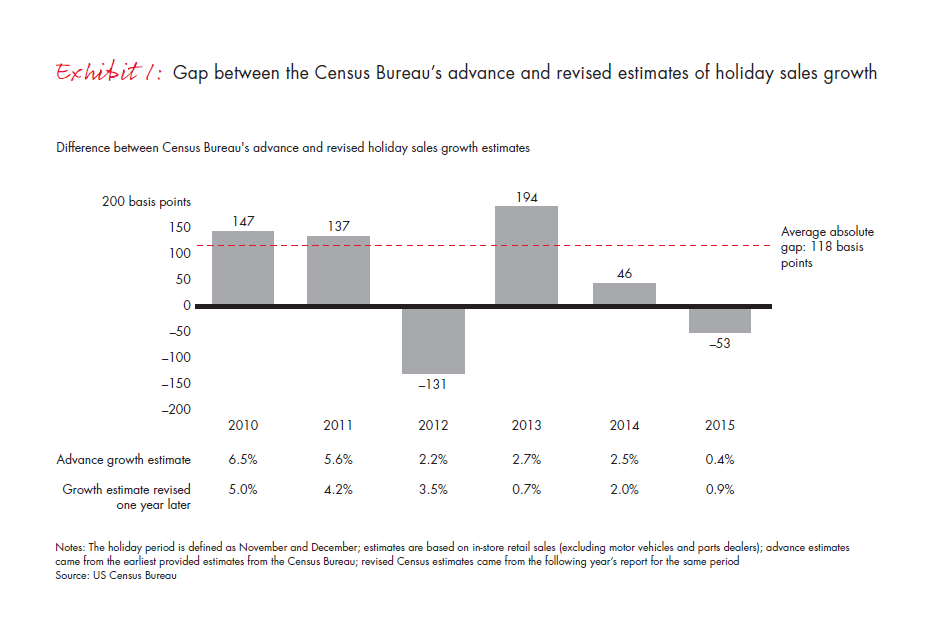
View the full PDF for a list of references
About Our Research Partners
Apptopia
Apptopia provides app store downloads, usage, revenue and software development kit data for mobile apps and publishers. Apptopia was founded on the belief that the mobile app community requires transparency to make way for innovation and industry advancements. Mobile publishers, developers, service providers and investors use Apptopia to understand and monitor competitors, to inform business strategies and to identify emerging consumer interests and trends. For more information, please visit www.apptopia.com.
Research Now
Research Now Group, Inc., is a global leader in digital data collection to power analytics and insights. Founded in 1999, the company was a pioneer in originating online data sampling. The company provides research data solutions for its 3,000 market research, consulting, media and corporate clients through access to more than 11 million deeply profiled business professionals and consumers. Research Now currently operates in over 40 countries from more than 20 offices around the globe, with locations in the Americas, Europe, the Middle East and the Asia-Pacific region. For more information, visit www.researchnow.com.
TXN Solutions
TXN Solutions is a web-based application that provides consumer insights and retail market trends based on spending data from more than 3 million credit cards and debit cards in its research panel. TXN provides retailers and merchants with insights on customer retention, share of wallet, competitive overlap and so on. For more information, please visit txn.com.
1The Net Promoter Score® is derived by asking consumers, “On a scale of zero to 10, how likely would you be to recommend this company (or this product) to friends and colleagues?” Ratings of 9 or 10 indicate promoters; 7 and 8, passives; and zero through 6, detractors. The score is simply the percentage of promoters minus the percentage of detractors. Net Promoter®, Net Promoter System®, Net Promoter Score® and NPS® are registered trademarks of Bain & Company, Inc., Fred Reichheld and Satmetrix Systems, Inc.






